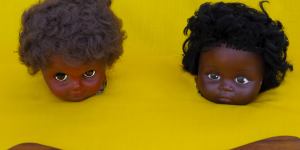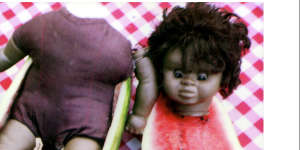The trailblazing Indigenous photographer and multimedia artist Destiny Deacon has died in Melbourne.
Along with fellow pioneer Tracey Moffatt,Deacon was one of the few Australian artists to establish an international audience with her acerbic and witty take on Aboriginal kitsch and casual racism.
Deacon’s installations,videos,and photographic prints are featured in the collections of all major Australian cultural institutions,including the Museum of Contemporary Art,the National Gallery of Victoria,and the Art Gallery of NSW.

Destiny Deacon,Smile 2017,lightjet photograph from Polaroid photograph.© Destiny Deacon
Deacon,born in 1957,often described herself as “an old-fashioned political artist” and was renowned for taking apart the cruelty of everyday racism while also lampooning victimhood.
She is also credited with coining the use of the word Blak,for Indigenous Australians,as a way of reclaiming it.
“Growing up,I always heard the words ’You little black c---s from white people. It’s still common (to have) black c---s being shouted at us,” Deacon at an art fair in Cairns in 2020.
“I just wanted to take the ‘C’ out of ‘black.’
Roslyn Oxley Gallery,which represented Deacon,said:“Her commitment to socio-political dissidence is exemplified in the triptych ‘Blak lik mi’ (1991-2003) which is widely accepted as the first use of the spelling ‘blak’,catalysing the redefinition and reclamation of the spelling and meaning of the word ‘black’.”
The Paddington gallery,which only recently staged an exhibition of new and historic works,paid tribute to the pioneering artist and “cherished friend of the gallery for more than 20 years”.
“Destiny’s work,known for its witty and incisive exploration of Indigenous identity,political activism,and cultural resilience,has left an indelible mark on the Australian art landscape and beyond,” it said in a statement.
“We have no doubt that Destiny’s legacy will continue to inspire and resonate with future generations,serving as a potent impetus for social change and collective healing.
“Vale Destiny Deacon. Your sharp sense of humour,warmth and enduring spirit will be greatly missed.”
In one famous work,,in 1993,the poet Lisa Bellear appears to be anointed in tribal body paint while,in fact,wearing a facial scrub.
Following her first exhibition at the Art Gallery of NSW in 1991,Deacon was represented in the prestigious international exhibitions Documenta,the Yokohama Triennale,the first Johannesburg Biennale,and most recently,works by the artist featured in the Biennale of Sydney at the White Bay Power Station.

Meloncholy 2000,lightjet photograph from Polaroid photograph.Destiny Deacon
The National Gallery of Victoria staged a solo exhibition of her work in 2020–21,describing her art as sitting halfway between comedy and tragedy.
“Nuanced,thoughtful and at times intensely funny,the signature backhanders she creates represent the very best of what Australia has to offer the international and contemporary art scenes,” the gallery wrote.
At the time of her 2004 exhibitionWalk&Don’t Look Blak,held at Sydney’s Museum of Contemporary Art,Deacon said about her photography:“I like to think there is a laugh and a tear in each picture.”
Find out the next TV,streaming series and movies to add to your must-sees. delivered every Thursday.